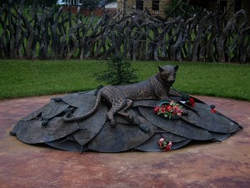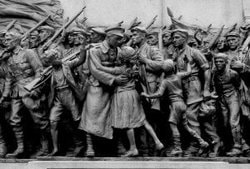World War I – The Great War – The First to Commemorate Veterans
The Tomb of the Unknown Soldier is one example of this. In war, there have always been soldiers who remain anonymous in death, whose remains cannot be identified. However, after World War I, an effort was made to remember them. In cities around the world, a tomb is set aside to symbolize all sacrifices made during war, and perhaps especially those who remain, forever, anonymous.
War memorials around the world have typically glorified war and victories. Only the Great War triggered an effort around the world to remember the huge sacrifice veterans make for their countries, and dedicate space and time to remembering that. In the UK and Canada, red poppies are worn on November 11th, symbolizing the battle at Flanders Fields. This year, the Tower of London is being filled with as many ceramic poppies as there were casualties in World War I, the moat is spilling over and, appropriately, turned blood red in the effort. The installation will remain until after November 11th.

A new memorial to an old war is the memorial by Peter Hall commemorating the Zulu battle at Rorke’s Drift, finished in 2005 and remembering a battle fought in 1878. The bronze sculpture is a leopard, symbolizing the Zulu chief, protecting Zulu shields. A Mphata tree stands in the center of the monument, which traditionally is planted to help bring home the spirit of one who has fallen far away from home, as many of the fallen Zulu soldiers did in this battle.
As one of the most told stories of war in history, with 3,000 Zulu soldiers battling 150 mostly sick British soldiers, the battle is memorable for many reasons: First, that the British held their ground against a formidable enemy, and second, the way it ended. The Zulu soldiers retreated, and after several hours regrouped and returned to the British hospital. As the British soldiers prepared for their inevitable defeat, instead the Zulu soldiers sang to them a song honouring their bravery.

The sheer numbers of casualties from World War 1 was unprecedented: 2 million Germans, 1.3 million French, 720,000 British along with 60,000 Canadians, 60,000 Australians and 18,000 New Zealanders. To put the number in perspective, in Australia, every second family lost a relative. In France, there were 1.3 widows and orphans. These statistics paint a picture that created a universal need to remember these losses and honour those who gave their lives in such a brutal manner. Though these were certainly not peace monuments, they have often in years since been used by the peace movement.
On November 11th, at 11:00, take a moment to remember the veterans who have fought for your country. Whether you have the chance to take part in a local Veteran’s Day memorial ceremony, or you take part in remembering quietly at home, setting aside time to remember those who have fought in war is important: whether you are pacifist or not.

 RSS Feed
RSS Feed